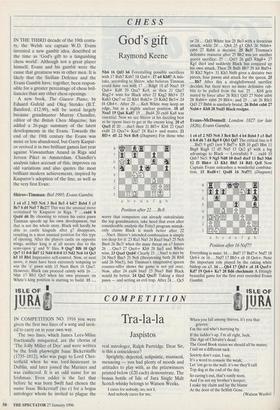CHESS
God's gift
Raymond Keene
IN THE THIRD decade of the 19th centu- ry, the Welsh sea captain W. D. Evans invented a new gambit idea, described at the time as 'God's gift to a languishing chess world'. Although not a great player himself, Evans and his gambit were the cause that greatness was in other men. It is likely that the Sicilian Defence and the Evans Gambit have, together, been respon- sible for a greater percentage of chess bril- liancies than any other chess openings.
A new book, The Giuoco Piano, by Eduard Gufeld and Oleg Stetsko (B.T. Batsford, £12.99), will be noted largely because grandmaster Murray Chandler, editor of the British Chess Magazine, has added a 26-page summary of the latest developments in the Evans. Towards the end of the 19th century the Evans was more or less abandoned, but Garry Kaspar- ov revived it in two brilliant games last year against Viswanathan Anand in Riga and Jeroen Piket in Amsterdam. Chandler's analysis takes account of this, improves on old variations and also quotes the most brilliant modern achievements, inspired by Kasparov's adoption of the line, as well as the very first Evan:.
Shirov-Timman: Bie11995; Evans Gambit.
I e4 e5 2 Nf3 Nc6 3 Bc4 Bc5 4 b4!? Bxb4 5 c3 Bel 6 d4 Na5 7 Be2!? This was the unusual move revitalised by Kasparov in Riga. 7 ...exd4 8 Qxd4 d6 By choosing to return his extra pawn Timman speeds up his own development, but that is not the whole story. Black will hardly be able to castle kingside after g7 disappears, resulting in a most unusual position for this type of opening. After the players castle on opposite wings, neither king is at all secure due to the semi-open `g' and 'b' files. 9 Qxg7 Bf6 10 Qg3 Qe7 110-0 Bd7 12 Nd4 0-0-0 13 Nd2 Nc6 14 Qe3 h5 15 Rbl Impressive self-control. Now, or next move, it must have been extremely tempting to win the 'a' pawn with 15 Nxc6 Bxc6 16 Qxa7. However, Black can proceed calmly with 16 ... Nh6 17 Rbl Qe5 when his own pressure on White's king position is starting to build. 15 ... Nh6 16 Qd3 b6 Forestalling possible sacrifices with 17 Rxb7 Kxb7 18 Qa6+. 17 a4 Kb8? A mis- take, according to Shirov, who believes Timman could have run with 17 ... Rdg8 18 a5 NxaS 19 Qa6+ Kd8 20 Qxa7 Ke8, as then 21 Qxc7 Rxg2+ wins for Black after 22 Kxg2 Bh3+ 23 Kxh3 Qxc7 or 22 Khl Rxh2+ 23 Kxh2 Be5+ 24 f4 Qh4+. After 20 ...Ke8 White may keep an edge, but in a highly unclear position. 18 a5 NxaS 19 Qa6 Ka8? 19 ...Bxd4 20 exd4 Ka8 was essential. Now we see Shirov at his dazzling best as he opens lines to get at the enemy king. 20 e5 QxeS If 20 ... dxe5 then 21 Bf3+ Kb8 22 Qxa5 exd4 23 Qxa7+ Kxa7 24 Ral+ and mates. 21 B13+ d5 22 Nc4 Bc8 (Diagram) For those who Position after 22 . . . Bc8
worry that computers can already outcalculate the top grandmasters, take heed that even after considerable analysis the Fritz3 program mistak- enly claims Black is much better after 22 ...Nxc4. Shirov's intended combination is simply too deep for it: 23 Ral Na5 24 Rxa5 bxa5 25 Nc6 Bxc6 26 Be3! when the mate threat on a7 forces 26 ... Qxe3 27 Qxc6+ Kb8 28 fxe3 and White wins. 23 Qxa5 Qxd4! Clearly 23 ... bxa5 is met by 24 Nxe5 Bxe5 25 Nc6 (threatening both 26 Rb8 and 26 Nxe5), but Timman's imaginative queen counter-offer shows the game is not yet over. Now, after 24 exd4 bxa5 25 Nxa5 Ba6 Black would be better. 24 Qa2 Qxc3! Taking a third pawn — and setting an evil trap. After 24 ... Qc5 or 24 ... Qd3 White has 25 Be3 with a ferocious attack, while 24 ... Qh4 25 g3 Qh3 26 Nxb6+ cxb6 27 Rxb6 is decisive. 25 Be3! Timman's defensive resource after 25 Bbl was yet another queen sacrifice: 25 ...Qxf3 26 gxf3 Rhg8+ 27 Kg1 dxc4 and suddenly Black has conjured up his own attack. Then 28 Bxf6 Bbl 29 h4 Bxf3+ 30 Kh2 Ng4+ 31 Kh3 Nxf6 gives a decisive two pieces, four pawns and attack for the queen. 25 ...Bb7 After this a straightforward sacrifice decides, but there were no more defensive rab- bits to be pulled from the hat. 25 ...Kb8 gets mated by force after 26 Rfcl Qd3 27 Nxb6 axb6 28 Rxb6+ cxb6 29 Bf4+, and 25 ...a6 26 Rfcl Qd3 27 Bxb6 is similarly brutal. 26 Bxb6 cxb6 27 Nxb6+ Kb8 28 NxdS Black resigns.
Evans-McDonnell: London 1827 (or late 1826); Evans Gambit.
1 e4 e5 2 NO Nc6 3 Bc4 Bc5 4 b4 Bxb4 5 c3 Ba5 6 0-0 d6 7 d4 Bg4 8 Qb3 Qd7 The critical line is 8
Bxf3 9 gxf3 (not 9 Bxf7+ Kf8 10 gxf3 Bb6 11 Bxg8 Rxg8 12 d5 Na5 13 Qc2 g5 with a big advantage to Black — Levenfish) 9 ... exd4 10 Qxb7 Ne5. 9 Ng5 Nd8 10 dxe5 dxe5 11 Ba3 Nh6 12 f3 Bb6+ 13 Khl Bh5 14 Rdl Qc8 Now Captain Evans unleashes a wonderful combina- tion. 15 Rxd8+! QxdS 16 Nxf7!! (Diagram) Position after 16 Nxf71!
Everything is mate: 16 ... Bxf7 17 Bxf7+ Nxf7 18 Qe6+ or 16 ... Nxf7 17 Bb5+ c6 18 Qe6+. Note the important role played by the raking white bishop on a3. 16 ... Qh4 17 Qb5+ c6 18 QxeS+ Kd7 19 Qe6+ Kc7 20 Bd6 checkmate A fittingly beautiful game for the first ever recorded Evans Gambit.


























































 Previous page
Previous page